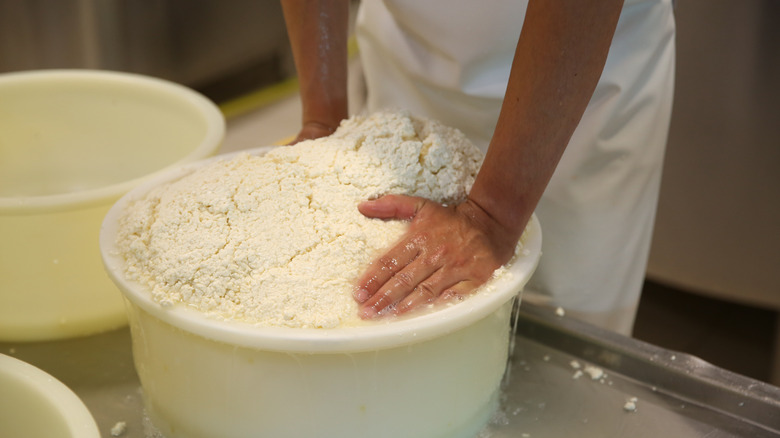How Exactly Are Cheese Curds Made?
Cheese curds are a favorite around the Northern U.S. all the way up to Quebec, where they're Canada's favorite French fry topper. They're one of the Midwest's most beloved forms of cheese, enjoyed as is or deep-fried for a gooey bite. If you were to make fresh cheddar cheese at home, cheese curds would be the photo after step one. Technically speaking, cheese curds are bite-sized chunks of coagulated milk. In other words, an unaged and unpressed cheese. Chefs actively avoid curdling when making a cream-based sauce, but when making cheese, curdling is all part of the process. Heat and acidity work together to break down the milk, producing its curd and whey, and like magic, cheese curds appear.
The process starts with cultures and fresh milk, typically pasteurized cow's milk, that is slowly heated. Recipes will differ depending on the cultures being used, calling for different temperatures ranging anywhere from 86 degrees Fahrenheit to 96 degrees Fahrenheit, with many recipes meeting in the middle at 90 degrees Fahrenheit. The cultures gradually acidify the milk, often with the help of calcium chloride, typically over the course of an hour or two. That's when rennet is added to the mix and then left to sit for 30 to 45 minutes. By that point, some little cheese curds should have floated to the top like perfectly cooked gnocchi, which means the curd is firming up. After slicing the sheet of curd, smashing any big chunks, and lots of tedious stirring, the curds are ready for the next and final step.
Cheese curds get their notable texture from the cheddaring process
Cheddar may seem like a simple cheese, but it requires an in-depth process called "cheddaring" that involves cutting cheese curds and repeatedly stacking them. The technique, established in the UK, helps create the perfect texture and acidity by squeezing every last bit of whey from the curds. Cheese curds can be made from other semi-hard cheeses like Monterey Jack, but cheese curds are most often made from young cheddar, especially in Wisconsin. Regardless, cheese curds undergo this same cheddaring process, which helps give them that notably bouncy chew.
Before cheese is molded into the perfectly uniform blocks we see at the supermarket, it naturally forms into these funky, irregular shapes. The taste is mild, but pleasantly salty. Aside from the distinctive shape, the real telling characteristic of curds is the audible squeak with each bite. Once you get past the infamous cheese curd squeak, they have a delightfully springy bite that distinguishes itself from any other cheese product. They add richness to any dish, as cheese does, but also texture.

